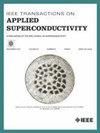超导体临界电流和n值神经网络建模中一种改进的数据调理方法
IF 1.8
3区 物理与天体物理
Q3 ENGINEERING, ELECTRICAL & ELECTRONIC
引用次数: 0
摘要
随着高温超导体(HTS)越来越多地被考虑用于交流应用,准确地模拟交流损耗是至关重要的。传统的金氏临界电流模型往往不能捕捉高温超导材料的温度依赖性或高场各向异性。相比之下,人工神经网络(ann)可以捕获大温度和磁场范围内的参数变化。然而,当可用的实验数据很少或分散时,正确训练人工神经网络是具有挑战性的。本文介绍了一种将原始实验数据集转换为光滑条件训练集的交互式方法。这些广泛的数据集非常适合用标准的机器学习工具训练具有关键电流和幂律指标参数的人工神经网络模型。该方法已在三种HTS产品上进行了验证。所有r值均大于0.96,模型无伪态。自场波动保持在$\mathbf {\pm}$0.71%以下,并且不存在过于陡峭的偏导数。相比之下,直接在原始数据上训练的ANN模型产生的自场波动高达$\mathbf {\pm}$22.9%,并且偏导数达到了n值模型不可接受的值。这些发现表明,基于人工神经网络的HTS模型可以将交流应用中的建模精度提高至少一个数量级。本文章由计算机程序翻译,如有差异,请以英文原文为准。
An Improved Data Conditioning Method for Neural Network Modeling of Superconductor Critical Currents and n-Values
As high-temperature superconductors (HTS) are increasingly being considered for ac applications, it is essential to model the ac losses accurately. Conventional Kim-type critical current models often fail to capture the temperature dependence or high-field anisotropy of HTS materials. By contrast, artificial neural networks (ANNs) can capture parameter variations over large temperature and magnetic field ranges. However, training ANNs properly is challenging when the available experimental data are scarce or scattered. This article introduces an interactive method to transform raw experimental datasets into smooth and conditioned training sets. These extensive datasets are excellent for training ANN models of both critical current and power-law index parameters with standard machine learning tools. The method has been validated on three HTS products. All R-values exceed 0.96, and the models show no spurious behavior. Self-field fluctuations stay below $\mathbf {\pm }$ $\mathbf {\pm }$ %, and the partial derivatives reach unacceptable values for the n-value models. These findings indicate that ANN-based HTS models can improve modeling accuracy in ac applications by at least one order of magnitude.
求助全文
通过发布文献求助,成功后即可免费获取论文全文。
去求助
来源期刊

IEEE Transactions on Applied Superconductivity
工程技术-工程:电子与电气
CiteScore
3.50
自引率
33.30%
发文量
650
审稿时长
2.3 months
期刊介绍:
IEEE Transactions on Applied Superconductivity (TAS) contains articles on the applications of superconductivity and other relevant technology. Electronic applications include analog and digital circuits employing thin films and active devices such as Josephson junctions. Large scale applications include magnets for power applications such as motors and generators, for magnetic resonance, for accelerators, and cable applications such as power transmission.
 求助内容:
求助内容: 应助结果提醒方式:
应助结果提醒方式:


